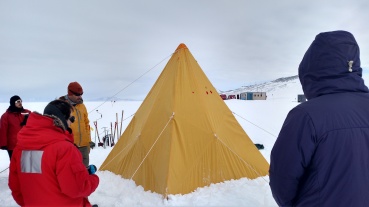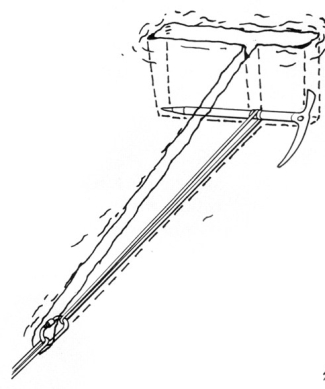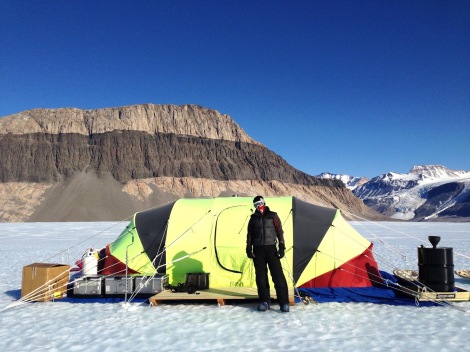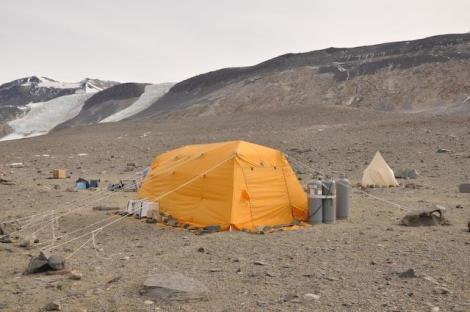Antarctica has a reputation, deservedly so, of being a place of extremes – extreme winds, extreme cold, extreme aridity – but McMurdo has been reasonably free of such brutality. The station is located on a southern peninsula on Ross Island in the middle of the Ross Sea off the Ross Ice Shelf, so named for Captain James Clark Ross, the British explorer who found the shelf in 1841. The peninsula sticks out into McMurdo Sound with the station nestled into a nook at the southern-most end surrounded by low-lying hills on three sides, with Observation (Ob) Hill to the east and the Scott Hut to the west. The more famous mountain, Mount Erebus, is to the north, nearly always obscured by cloud cover and, despite being the tallest active volcano on the continent at over 12,000 feet, it’s completely hidden from view from the base itself due to the immediacy of the surrounding hills. To the east of Erebus, some ways behind Ob Hill, is Mt. Terror – the two were also named by Ross, after the two ships he sailed to the continent. Considering what this place must have looked like when he landed (especially since Erebus was erupting at the time), I can completely understand why he named one after the Greek god of darkness where the dead pass to go to Hades, and the other for the feeling this must have inspired.
The reason I bring this up is that the surrounding hills create something called a wind shadow, whereby the hills block a lot of the wind and weather coming up from the continent and the surrounding ocean, allowing for a respite from much of the extremes experiences elsewhere. This is not to say it isn’t cold or windy on base – it definitely is – but the worst of this is off-base, on the sea ice and on the shelf. In our sea ice training, the wind was significant, but there was shelter in the Hagglund. For the deep field training, we would only have our tents and snow trenches as cover.
Deep field training has a special place in the hearts of many grantees. It’s often the first time that many of them have camped in winter conditions, and for most it’s the first time camping on an open ice field. Known affectionately as “Happy Camper”, the training is a crash course in how to deploy and set up a deep field camp, including where to cook, when to dig T-slots, and how to cut snow blocks for a wall. It’s a full two days, with some brief classroom work in the morning of the first day followed by a full day outdoors of setting up all the tents and digging out protections before spending the night in the open. The morning is filled with breaking the entire camp down and packing up, followed by a brief lecture on HF radios.
Our instructor was Loomy, an Alaskan native who chews tobacco and was sad that the weather forecast called for calm and relatively warm conditions. After the requisite PowerPoint presentation on how best to avoid having your entire camp get blown away in a storm and how to avoid frostbite, we packed up our sleep kits and ECW bags into a Hagglund and ourselves into a giant bus-like thing called a Delta, we headed off to the sea ice on the east side of the peninsula. It takes about a half hour to get there – our group consists of the eight of us, a particle physics group studying neutrinos, an energy specialist looking into miniaturizing wind turbines, and a carpenter, with five instructors, four of whom are in-training with Loomy to teach this on their own next time. It’s a large group, which has its pros and cons. The Delta drops us off about a kilometer or so from the campsite itself, which is appropriately called Happy Camper, and we grab our ECW to hoof it over the snow to the prepared fishhut that will be our safe space if something goes disastrously wrong. (Spoiler alert: it didn’t.)
The first tent we set up is called a Scott Tent. It’s a classically-shaped orange pyramidal teepee with four poles pre-arranged on the corners for ease of deployment. Super easy to set up even in bad conditions, it’s the first tent to put up in any deep field camp due to it’s “bombproof” status, that is, if terrible weather comes in and the Scott tent is properly setup, it will nearly certainly survive. It pops open and we shovel snow onto the skirt to keep it from blowing away, though in the current conditions of approximately no wind, this isn’t likely. Loomy demonstrates the proper way to guy out a tent, meaning to secure it to the ground, by use of a T-slot and a trucker’s hitch. A T-slot is a T-shaped hole that on
teepee with four poles pre-arranged on the corners for ease of deployment. Super easy to set up even in bad conditions, it’s the first tent to put up in any deep field camp due to it’s “bombproof” status, that is, if terrible weather comes in and the Scott tent is properly setup, it will nearly certainly survive. It pops open and we shovel snow onto the skirt to keep it from blowing away, though in the current conditions of approximately no wind, this isn’t likely. Loomy demonstrates the proper way to guy out a tent, meaning to secure it to the ground, by use of a T-slot and a trucker’s hitch. A T-slot is a T-shaped hole that on

- A T-slot construction, with the tent to the lower-left of the image. Guylines would be secured with a trucker’s hitch rather than a carabiner. Credit: https://goo.gl/UiCCeZ
e digs out in the ground with the top of the ‘T’ perpendicular to the particular line you’re tying down. This portion is dug out first, and the line is then wrapped once around a stick, ice-axe, or other straight, firm, device – we used a piece of bamboo flag pole – which is then dropped in the small trench. The bottom portion of the ‘T’ is narrowly carved out back towards the tent, creating a thin notch for the line to sit in such that it comes out from the tent, through the slice in the snow, around the bamboo stick, back out the slice, and back to the tent. This can be secured using a trucker’s hitch, which can be easily tied and later untied to tighten – when the winds pick up, the ropes stretch, so tightening guylines is a constant necessity on the ice.
With the Scott Tent up, we move on to the Endurance tents. Known as “Endos”, these tents were actually originally developed right here in Antarctica before being picked up for commercial distribution worldwide. They’re rainbow-colored, oblong, pill-shaped tents that also has an internal skeleton around the curved edges that act as ribs. These are easily attached to internal posts to form the basic shape before using a metal piece called a spreader bar to force the two half-domes apart, creating the pill shape. This is a relatively easy tent to assemble, only requiring a few people, and is also considered “bombproof” due to the curvature and the collapsible nature of the internal structure is things go awry. We’ll have two of these in the deep field for our science operations.

Fully deployed endurance tent at Blood Falls in the McMurdo Dry Valleys of Antarctica, guyed out and with a person for scale. Credit: https://goo.gl/dzCA9L
The third and final large tent to set up is called the Arctic Oven, or the “AO”. This one is more like a traditional tent, albeit larger, with an exoskeleton of tent poles and a full fly. This is harder to assemble, and it’s much more of an assembly than a deployment. It’s not something I’d like to put up in anything but Con 3 weather, that is, nice for Antarctica, least of all because I’m not tall enough to easily push the whole thing up. Nice when it’s assembled though, since I can fully stand in it everywhere. It’s got more room than the previous two, with a nice vent on top and fire-retardant material, so it’s often used as a cook tent. Still have to be wary of carbon monoxide poisoning, but that’s anywhere indoors. We’ll be setting one of these any time we deploy on the sea ice away from the fish hut, and we’ll have one as an extra tent when we go to the deep field to use for whatever we want.

A fully assembled Arctic Oven deployed in Taylor Valley of the McMurdo Dry Valleys, complete with orange fly; the internal skin is white. The fuel canisters on the right are 100lbs each, for some sense of scale. Note the Scott Tent in the background. Credit: https://goo.gl/m9f1mQ
With these three tents set up, it’s time to build a snow wall to protect the camp from wind and debris. Right now it’s not windy, but down here wind can come from nowhere in a hurry, so we want to be protected. To do this, we’ll cut out snow blocks from a quarry, which is a region of untouched snow outside the camp nearby, using snow saws.

- A typical snow saw. Credit: https://goo.gl/DwWK3y
The quarry is important because the snow pack here is made of delicate layers of packed snow that is so densely packed that it stays strong and can be carved into various shapes and sizes, but one step on it can break those layers, destroying it’s intrinsic strength. Thus nobody can walk in the quarry, only on the edges. To facilitate this, a trench is dug around the perimeter to delineate it, and only one or two people should cut the blocks; this also helps with block uniformity, important to reduce cracks and gaps within the wall itself. For us, we only dig the trench on

Digging the quarry boundaries.
two sides, and everyone gets to cut some blocks. The snow saws are used for dimensioning as well – the full blade for the height and depth, and the full saw for the width. It’s fun work and not as challenging as I thought since the snow is easily cut using these snow machetes, though getting the blocks out can be tough – I ruined at least one doing this. But we get through it and dig enough blocks for a twenty-foot or so long wall about three feet high – good enough for these condition.
With the wall completed (or as completed as it’s going to be), Loomy continues the show by demonstrating the construction of a snow trench, which is quite literally what it sounds like: a trench in the snow that one digs out and covers with snow blocks.
- My snow trench, full of gear on the right.
Generally this would be done only when one doesn’t have an appropriate tent, but in the safe confines of Happy Camper, six of us elect to continue this, while the rest split off to build their standard-issue mountain tents. One of the nice parts of Antarctica is the lack of a sunset means that there’s no rush to get everything done, other than needing sleep, so we enjoy the process. One of the Campers, a Norwegian named Hans, is a pro – he digs the entire thing and cuts the roof out within two hours. Apparently, he does this reasonably frequently for his kids, so I try to take his advice about building them. The trick is to make the cross-section bell-shaped so that it’s narrower at the top (smaller ice blocks required) and wider at the bottom (more room for sleeping). It’s a fun slog, but at the end when it’s time to get into it, it’s a tight fit with all the stuff while attempting to keep as much as possible free of snow. Dinner is a simple affair of rehydrated bagged dinners and hot chocolate before crawling in with a nalgene of hot water – now this is luxury.
The night was rough for me – I should’ve known better than to sleep in a confined space – but it was still an enjoyable and unique experience, one I will never do again if possible. Others did better – Justin said it was the best night of sleep he’d had in weeks, which may say something since I’m his roommate on station, and Dan also reported enjoying the confines, especially since he managed to surreptitiously drill his way through into Justin’s trench during the evening and got some great photos. Hans choose to sleep in a tent, despite his expertly crafted masterpiece of a trench. However we slept, it was abruptly ended by Josh, who had taken on the Camp Manager role, at 0630, with a complete breakdown of the camp by 0800. This included all tents disassembled and packed, all staked reclaimed from the T-slots, all sharps and flags bundled and stowed, and all holes and trenches filled in. It’s a big job, but a little hot water and instant coffee later, everyone is humming along to get it done and by 0830 we’re sitting in the warm instructor’s fish hut drinking hot chocolate, eating oatmeal, and nibbling on trail mix.
The morning is then spent discussing the HF (or Short Wave) radio that can be deployed in the deep field if other communication methods aren’t working. Not that HF radio is perfect – it bounces signals off the ionosphere to travel long distances, and a lot can go wrong, but they can be critical in a pinch. The radio itself looks like it might have come out of Vietnam, and we unspool the antenna, the length of which is modulated by a series of plugs that continue or break the connection. Somewhat amazingly (though I should not be surprised by this anymore), the crazy looking setup works nearly flawlessly, and we radio South Pole successfully for a radio check – nearly 1000 miles!
The curriculum completed and all the bags packed on the Hagglund, we trek back to the Happy Camper junction while tossing a frisbee around in the windless air. It’s amazing how hot you get from moving around; when I shoveled the previous evening, I went from five layers to just my silk base layer and gloves in fifteen minutes, and even on this walk, everyone is unzipping or removing Big Red. This is why we layer down here, where sweat can chill you to the core. We board the Delta to head back to station and I promptly fall asleep to the rocking motion of the bus over the Ice.


































This was so interesting! I couldn’t imagine literally sleeping in snow nor could I really imagine being surrounded by ice all the time. Despite the cold this seems like such a breathtaking experience! Was it a hard transition for you all when you first arrived?
LikeLike
Hi Jamie!
It’s definitely an interesting transition! You never really get used to the surroundings because it’s so unique, but you do settle into a routine. The food is familiar, and there are beds to sleep in, so all that is relatively easy. The harder part is the midnight sun thing; for these few months (until Feb. 20th, in fact), the sun is always up! Makes it a little hard to sleep, but even more so, it’s hard to know when to stop working since there’s no environmental cues! Definitely takes a few days to get used to it.
Thanks for stopping by!
LikeLike
Not quite sure how to word this question but how much work do you put in on an average day? I would imagine quite a bit considering day time is practically all of the time but I would imagine the lack of sleep would ultimately have a negative affect on work ethic?
LikeLike
Hi Jamie!
We’re normally in the lab by eight and out around ten or so, with two hour-ish breaks for lunch and dinner, so they’re about twelve hours of work a day. We could go longer, but burn-out is a real thing. On days where we’re out on the sea ice, we can be out there for 14 hours or longer, depending on how the deployment is going. It’s true that the sun is up all day, every day, but people still get tired.
Thanks for asking!
LikeLike
CAC student here.
I found it quite interesting how you all dug into the ice to make a cave like shelter. This would be interesting but also kind of scary considering things are so confined. Personally I would’t last due to having panic attacks. It seems like you all learned a lot about survival in this region. Loomy seems like the character considering he was wishing it was worse weather conditions lol..Im sure this would have made it a lot more challenging if the weather conditions were a lot worse.
LikeLike
Hi Stephen!
Yeah, turns out, I don’t do so well on confined spaces either! I managed about 45 minutes of sleep the whole night, but it was still a worthwhile experience! They used to do these trips as long as it was Condition 2 or Condition 3 (that is, more than a quarter mile of visibility, above -75F, and less than 55 knot winds), but they’ve changed it, so now it’s only Con3, thankfully. I’d never have done it in less than perfect conditions, which it was!
Thanks for reading!
LikeLike